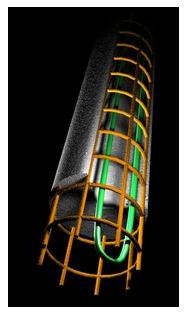The EPFL Congress Center will have energy-efficient foundations

© 2011 Alain Herzog
Five energy-efficient piles are being installed between end-May and the beginning of June in the foundations of the future building. They will enable research to be performed on the leveraging of geothermal energy and the mechanical behavior of the foundations.
A new crane has appeared on the building site. It will allow the insertion of 20-meter-long metal structures, in one piece, in the wells dug at the back of the future Congress Center. These piles, sunk in concrete, are not only structural and supporting foundation elements, but will also act as heat exchangers. “Half of the CO2 produced in Switzerland comes from buildings. The sub-soil has excellent heat-storing properties. It represents a potential for renewable energy that is ecological and directly usable”. Professor Lyesse Laloui, Director of the Laboratory of Soil Mechanics (LMS), is working at the leading-edge of this discipline. Eleven years ago, he installed the first energy-transmitting pile at EPFL. This test-pile, a world “first” and bristling with sensors, enables the measurement – internally – of constraints, movements and temperature variations. The LMS has perfected tools enabling measurement, analysis and prediction that are today used internationally in the development of this technology, and EPFL remains the world leader in this area. The installation of five geothermic structures under the Congress Center will allow Professor Laloui’s team to study the exact functioning of a group of energy-transmitting piles and their impact on the surrounding terrain, which has never been performed before.
“Half of the CO2 produced in Switzerland comes from buildings. The sub-soil has excellent heat-storing properties. It represents a potential for renewable energy that is ecological and directly usable”. Professor Lyesse Laloui, Director of the Laboratory of Soil Mechanics (LMS), is working at the leading-edge of this discipline. Eleven years ago, he installed the first energy-transmitting pile at EPFL. This test-pile, a world “first” and bristling with sensors, enables the measurement – internally – of constraints, movements and temperature variations. The LMS has perfected tools enabling measurement, analysis and prediction that are today used internationally in the development of this technology, and EPFL remains the world leader in this area. The installation of five geothermic structures under the Congress Center will allow Professor Laloui’s team to study the exact functioning of a group of energy-transmitting piles and their impact on the surrounding terrain, which has never been performed before.
Francis-Luc Perret, vice-president for School planning and logistics, is convinced: “This technology is intelligent and potentially inexpensive to deploy if considered well ahead of the project development. As far as the Congress Center is concerned, we have left it a bit late. However, if the demonstration is conclusive, I hope that future EPFL buildings will be constructed in this way.” It is also hoped that, in the near future, the future hospital of the Chablais region will also benefit from it.
How does it work?
Very low energy geothermics is a domain that uses resources situated at depths of between 1 and 100 meters from ground-level. The temperature of this layer is more or less stable, situated between 10 and 12 degrees throughout the year, which represents a reliable source of heat. The use of heat pumps to leverage this source of energy is already well established. The piles are connected to thermal exchangers encased in concrete tubes, through which flows a coolant. The hydraulic circuit is connected to a reversible heat-pump system. Thus, the foundations fulfil the role of heat source in cold periods, and a source of cold in warm periods.

This technology also enables seasonal storage of energy produced by solar panels in the sub-soil.
“In the Congress Center, we will benefit from an analytical laboratory that will include all the elements necessary for heating and measurement. The five structures, equipped with optical fibers and pressure cells, will help us to understand and subsequently to explain the exact functioning of a group of energy-transmitting piles, and this will provide us with essential information on their behavior and their impact within the available volume under the foundations, which is about 200m3.” Professor Laloui is also working with The Cambridge-MIT Institute and the University of Beijing on a much more ambitious project: that of an urban area the size of EPFL, built entirely on energy-efficient foundations. "In this case, we will have to look into the hydrogeological consequences of such constructions on the global stability of the region. This is even more important than usual, because in this particular research project we will be drilling very deep, where the water is about 100 degrees, before storing the energy in the foundations of buildings.”
This experiment, involving the foundations of the Congress Center, will be the focus of an international workshop that Professor Laloui is organizing in January 2012, which has obtained the support of the American National Scientific Fund.